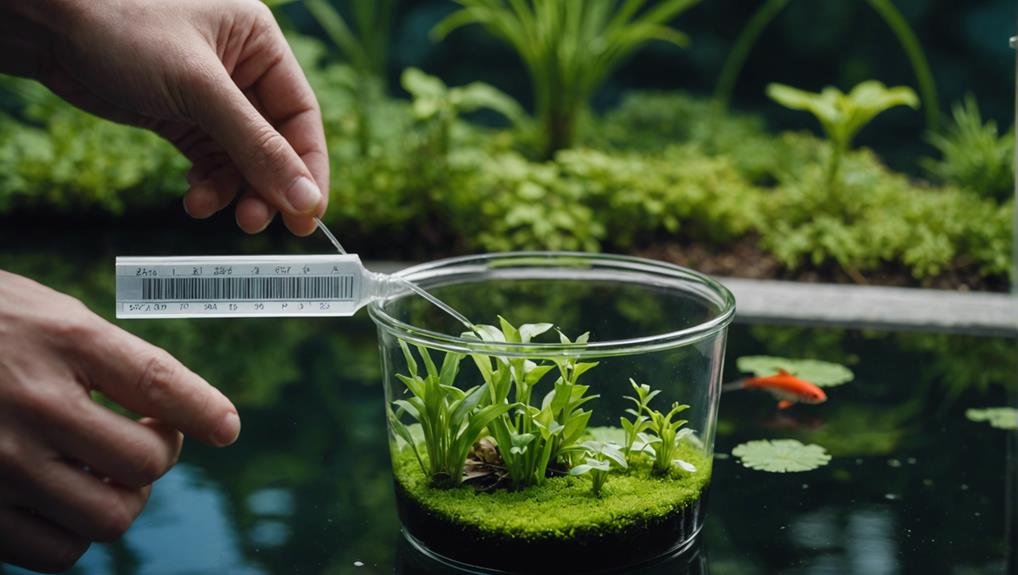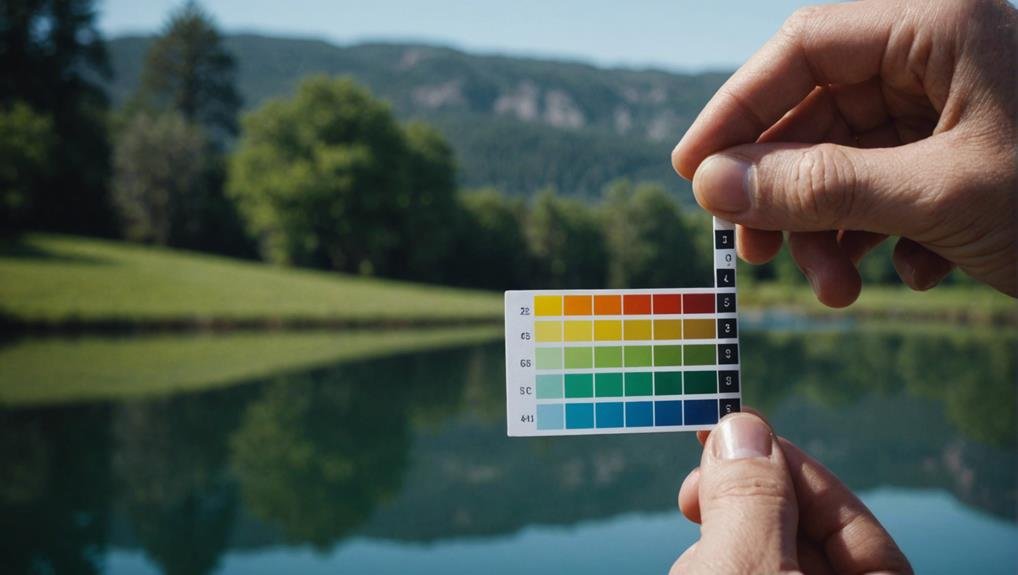Testing the pond water is crucial for maintaining a healthy ecosystem. There are various methods to test water quality, such as using test strips, liquid test kits, electronic probes, or even sending samples for laboratory analysis. Test strips offer quick results but may lack precision, while liquid kits provide more accurate readings, especially for harmful substances like ammonia. Electronic probes give real-time data, and laboratory analysis offers a detailed overview of the water condition.
Key parameters to monitor include pH levels between 6.5 and 8.5, low levels of ammonia, and phosphate below 0.05 parts per million (PPM).
Regular testing and adjusting water conditions based on the results are essential to keep the pond environment balanced and thriving.
For those looking for recommendations, API Pond Master Test Kit and Tetra EasyStrips 6-in-1 Pond Test Strips are popular choices among pond owners for their reliability and ease of use.
By regularly testing the pond water and taking necessary actions, we can ensure a safe and healthy habitat for aquatic life.
Types of Pond Water Tests
Monitoring pond water quality effectively involves using various testing methods like test strips, liquid test kits, electronic probes, and laboratory analysis. Each method offers unique benefits, helping us maintain a close watch on the water's health.
Test strips are a convenient choice for quick water testing, measuring parameters such as pH, ammonia levels, nitrites, nitrates, and water hardness. While easy to use, they may not provide as precise results as other methods.
Liquid test kits, on the other hand, offer more accurate readings by adding reagent drops to a water sample, especially valuable for monitoring harmful ammonia levels.
For precise measurements of indicators like pH and dissolved oxygen levels, electronic probes are advanced tools that provide real-time data.
For a comprehensive analysis, sending water samples to a laboratory can offer detailed insights into overall water quality, identifying potential issues and nutrient balance in the water.
Key Water Quality Indicators
To maintain a healthy pond ecosystem, it's crucial to regularly test key water quality indicators. Monitoring pH levels, which show how acidic or alkaline the water is, is vital. The ideal pH range for pond water is between 6.5 and 8.5. Any deviations from this range can stress aquatic life and promote harmful algae growth. By keeping a close eye on pH levels, we can ensure a balanced environment for our pond inhabitants.
Another essential indicator to monitor is ammonia levels. High levels of ammonia can be toxic to fish, so it's important to keep them as low as possible. Regular testing allows us to detect any spikes in ammonia levels promptly and take necessary actions to protect our aquatic friends.
Phosphate levels are also critical to monitor. Elevated phosphate levels can lead to disruptive algae blooms in the pond. To prevent this, it's advisable to keep phosphate levels below 0.05 parts per million (PPM).
Additionally, before introducing fish to the pond, it's crucial to ensure that chlorine levels are below 0.01 PPM to prevent any harmful effects on the fish.
Performing a Strip Test

One easy and effective way to check the water quality in our pond is by regularly using water testing strips. To begin, purchase a pond-specific water testing strip kit from a local aquarium or hardware store.
Once you have the kit, follow these steps to test the water.
Dip the strip into the pond water for a few seconds as instructed in the kit. Wait for about a minute for the colors on the strip to develop. Patience is crucial here to ensure accurate results.
After the waiting period, compare the colors on the strip to the provided color chart. This comparison will help you determine the levels of important parameters like pH, ammonia, nitrite, nitrate, and other relevant indicators.
Monitoring these levels is essential for maintaining a healthy pond environment. If you notice high ammonia levels, take immediate action to protect aquatic life.
Regular testing allows you to catch any issues early on, ensuring your pond remains a safe and thriving habitat.
Conducting a Liquid Dropper Test
To ensure our pond water remains clean and healthy, it's essential to conduct regular tests using a liquid dropper test kit designed for pond water. This kit enables us to check crucial parameters that impact water quality and the well-being of aquatic life.
Begin by carefully following the kit's instructions to collect a water sample from the pond. Using the dropper bottles provided, add the specified number of drops for each parameter being tested, such as pH, ammonia, nitrite, nitrate, and General Hardness (GH).
GH is particularly important as it measures the concentration of minerals like calcium carbonate, vital for the health of aquatic organisms. After adding the drops, observe the color changes in the water sample. Comparing these colors to the provided chart will help determine the levels of each parameter accurately.
Regular testing allows us to keep track of water quality, making it easier to maintain ideal conditions for our pond's inhabitants. By proactively monitoring and treating the water, we can prevent potential issues from escalating. This approach ensures a thriving and balanced ecosystem for our fish and other aquatic life.
Interpreting Test Results

Understanding and interpreting test results accurately is crucial for maintaining a healthy pond ecosystem. Each parameter we test for plays a key role in the overall well-being of our pond. For example, it's important to keep a close eye on ammonia levels because high levels can stress fish and have a negative impact on the environment. Similarly, maintaining a pH level around 7.4 is essential for optimal fish health and to support important biological processes in the pond.
To grasp the significance of each parameter, let's refer to the table below:
| Parameter | Ideal Range |
|---|---|
| Ammonia | 0 PPM |
| pH | Around 7.4 |
| Carbonate Hardness (KH) | ~125 PPM |
| Nitrites | Below 0.25 PPM |
| Nitrates | 20-60 PPM |
Carbonate hardness (KH) is crucial for maintaining stable pH levels by acting as a buffer. External factors such as nitrogen-containing fertilizers can impact surface water, disrupting the nitrogen cycle and causing imbalances. Keeping nitrites below 0.25 PPM and nitrates between 20 and 60 PPM helps create an optimal environment for our pond.
Understanding these results empowers us to make well-informed decisions about pond management, ultimately fostering a thriving ecosystem for all aquatic life.
Maintaining Water Quality
Maintaining water quality in our pond is crucial for the well-being of the aquatic ecosystem. Regular testing of pH, ammonia, nitrate, and dissolved oxygen levels is essential to ensure that all parameters are within the optimal range. Utilizing test kits, pH meters, and water testing strips simplifies this process, making it both convenient and accurate.
To prevent potential issues, it's important to incorporate routine water changes, particularly when using tap water that may contain impurities. Aeration systems play a significant role in boosting oxygen levels, which are vital for the fish and beneficial bacteria in the pond. These bacteria play a crucial role in breaking down waste as part of the nitrogen cycle, converting harmful ammonia into less harmful substances.
Monitoring nutrient levels is another critical aspect of maintaining water quality. Excessive nutrients can result in algae blooms, which can negatively impact the pond's ecosystem. By feeding the fish an appropriate amount of food and promptly removing any uneaten portions, we can effectively manage nutrient input. Additionally, beneficial bacteria aid in regulating nutrient levels to prevent imbalances.
Establishing a biweekly testing routine during warmer months and conducting monthly tests in cooler periods allows us to promptly address any potential issues. Consistent monitoring and maintenance efforts are key to preserving the optimal condition of the pond water, ultimately fostering a thriving ecosystem.
Conclusion
Regularly testing the water in our pond is crucial for maintaining a healthy environment for our aquatic life. Keeping an eye on key indicators like pH, ammonia, and nitrate levels allows us to address any issues before they escalate.
For instance, last year, we noticed some unusual behavior in our fish. A simple strip test revealed high ammonia levels, prompting us to take immediate corrective measures. Consistent testing and upkeep are essential to ensure our pond remains a vibrant and thriving ecosystem.
Let's proactively safeguard our water quality to keep our pond flourishing.

